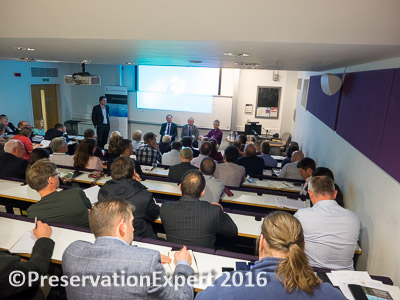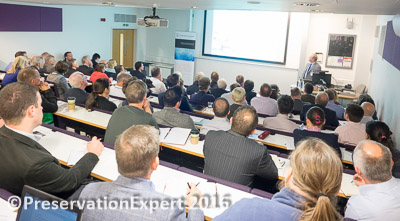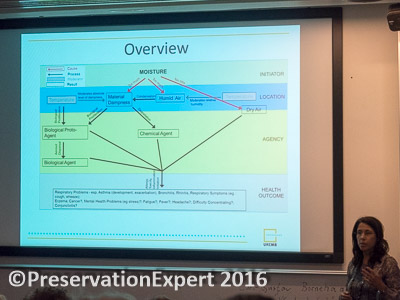The UK Centre for Moisture in Buildings (UKCMB)
Last Wednesday I was in London for the launch of the UKCMB. The launch was at the Roberts Building, University Collage London. About 100 interested parties were invited along to hear about the UKCMB and find out how they could get involved with its work. I was there with PCA CEO Stephen Hodgson.
The UKCMB is an independent, not for profit, public good organisation run by University College London, the Building Research Establishment (BRE), Heriot Watt University and the London School of Hygiene and Tropical Medicine.
This was Neil May’s opportunity to introduce us to his friends and fellow dampness in building experts from Lund University, Sweden. The Swedish team were headed by Prof Lars-Erik Harderup, with his team; Dr Magnus Ahs and Prof Jesper Arfvidsson.
The Swedish National Moisture centre is based in Lund University and has been at the core of a real revolution in the handling of dampness in buildings in Sweden. Neil is keen to learn from their experience and create a similar centre, here in London, where skills can be built and knowledge shared.
The FuktCentrum
During the morning sessions we were treated to an in-depth look at the work of the Swedish centre and the activities of the FuktCentrum as a whole. It was fascinating listening to the story behind the creation of the FuktCentrum. It basically arose in response to the avalanche of dampness issues effecting new buildings erected in the past ten or 20 years. Prof Harderup explained how people were becoming exasperated with the serious and unforeseen damp penetration and condensation defects, which presented within a few short years of completion.
Something had to be done to improve design and site practice. The improved research and the training and qualifications that this engendered, has really improved professional standards, where dampness in buildings is concerned.
UKCMB – launched!
After lunch Neil took the stage to outline the aims of the UKCMB, its organisation, program, current and future projects. These range from on-site testing of environmental checks, alongside sponsor Polygon, as well as planned research with the Property Care Associating as part of a planned Knowledge Transfer Partnership. Neil challenged delegates to come forward with their aspirations and problems so that together, UKCMB and the wider industry can work to improve understanding of moisture in buildings for the ‘public good’.
The sessions in the afternoon included a series of brainstorming discussions on:
- Retrofit risks and unknowns
- Flooding and Escape of Water
- Timber in Buildings
- Improving moisture safety in Buildings
- Moisture and people in Buildings (Health and building use).
I managed to attend two of these and was taken by the breadth of opinions and also the enthusiasm of those in attendance.
A call to get involved with UKCMB
Neil closed the day, repeating his call for delegates to get involved by prompting research goals and offering help.
The Swedish connection is a good fit. I have to say I was a little sceptical, but after listening to the Swedes I came to see that there really is a strong correlation, between their past experience and what we practitioners are seeing out in the wider world of surveying. I can’t wait to get involved and will be sending on some ideas and data I’ve collected this past few years.
I hope and expect that the UKCMB will enable a leap forward in knowledge and skills in diagnosis and treatment of dampness, as well as pushing design forward, to help avoid issues developing in the first place. Anyone wishing to get more information or, who need research or want to offer help should contact Neil May.
So what does the UKCMB mean to us surveyors? Well I think that at last we’ll have a cutting edge resource for sharing and learning about dampness in buildings. It means that those of us who are exploring ways of improving outcomes for consumers with dampness problems will have help at last. We won’t be on our own – that must be a good thing.
Have a look at this cases study carried out by one of my surveyors this past winter, using humidity and temperature data logging to help a landlord with a perennial mould problem. Science has a part to play in our day to day work.
Dry Rot.
For more on the cutting edge damp diagnosis PCA members are involved in try my good friend Ross Charters’ blog – https://blog.completepreservation.co.uk/2016/04/07/why-is-there-a-damp-patch-and-staining-on-my-chimney-breast/
https://www.preservationexpert.co.uk/relative-humidity-and-vapour-pressure-which-is-best/




Thanks Bryan,
As I understand it in Northern Sweden it is so cold that their structures are constructed to be very air-tight and the likes of Corroventa (Swedish firm) dehumidifiers are used to help control the internal environment. It’s interesting to see that they’ve had their issues with it.
Regards,
James
Hi James,
Thanks for looking in.
What surprised me were the Swedes insistence that their western coast is in effect very similar in environment to our own. Very wet and not that cold. Yes, it’s colder in the North but it seems that our airtight homes are becoming almost as sealed-up as theirs are. They’ve been demolishing homes built only a decade ago due to mould and wet rot in timber frames…. A time bomb waiting to happen here.
Thanks Bryan for bring this matter to a greater audience.
I found article on mouldy student lets particularly interesting. In WW2 I have sat in a bath,only allowed once a week, with a draught blowing in my face from the overflow pipe,where you could see the trees or house next door. Was this dispersing the carbon monoxide ?. Hot water dribbling from a gas fired copper geyser, which, when lit “exploded” into action, causing the chimney hood to leap in the air, hopefully not in the bath. Central heating was rare,it required hand stoking.of a coke boiler.
Building must fit the life style of the people. however “difficult” they are.
Can more research be done on passive ventilation by venturi action. Mechanical systems are good but what happens when the electricity fails. I have seen half a village in difficulty when the electric sewerage pump failed.
Are you minded to publish this report in Journal of:Building Survey,Appraisal & Valuation – .Henry Steward.
Venturi not only work for toasters & vacuum cleaners, but buildings as well.